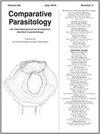Parasite Infections in an Argentinian Municipal Shelter (Patagonia, Río Negro)
IF 0.4
4区 医学
Q4 PARASITOLOGY
引用次数: 1
Abstract
ABSTRACT: Abandonment, irresponsible care, and overpopulation are the main causes of the large number of dogs roaming free in urban areas or living in shelters. These shelters provide temporary homes for dogs that have been lost, abused, or reported for biting, but also provide an environment that could enable the spread of gastrointestinal parasites. City municipal shelters receive dogs throughout the year, feed them, and provide veterinary care before offering them for adoption. This article reports on the intestinal parasite infections of municipal shelter dogs from San Carlos de Bariloche, Río Negro, Argentina, over 3 consecutive years. Fecal samples were collected from all shelter dogs during the winters of 2017, 2018, and 2019. The samples were examined using Sheather's flotation and Ziehl Neelsen stain techniques to detect parasite eggs and coccidia, respectively. Total prevalence values ranged from 32 to 45%, with a total of 6 parasite taxa found, including coinfections, with a maximum of 2 species. Some dogs seemed to become infected during their stay in the shelter, and despite periodic deworming, some dogs were still parasitized. Zoonotic parasites like Toxocara canis, Toxascaris leonina, and Dibothriocephalus latus were identified in this study. Thus, such shelter dogs may act as disseminators of transmission stages of zoonotic parasites. This work emphasizes the importance of raising awareness about the responsible care of companion animals to prevent the need for shelter care.阿根廷市政收容所的寄生虫感染(巴塔哥尼亚,Río Negro)
摘要:遗弃、不负责任的照顾和人口过多是导致大量狗在城市地区自由游荡或住在收容所的主要原因。这些收容所为走失、虐待或被报告咬人的狗提供了临时住所,但也提供了一个可能导致胃肠道寄生虫传播的环境。城市市政收容所全年接收狗,喂养它们,并在提供收养之前提供兽医护理。本文报道了阿根廷内格罗圣卡洛斯市Bariloche市市政收容所犬只连续3年的肠道寄生虫感染情况。在2017年、2018年和2019年的冬天,从所有收容所的狗身上采集了粪便样本。使用Shepherer的浮选和Ziehl-Neelsen染色技术分别检测寄生虫卵和球虫。总流行率在32%至45%之间,共发现6个寄生虫分类群,包括共感染,最多2个物种。一些狗在收容所期间似乎被感染了,尽管定期驱虫,但一些狗仍然被寄生。在这项研究中鉴定出了犬弓形虫、leona弓形虫和扁头二头虫等人畜共患寄生虫。因此,这种收容所的狗可能是人畜共患寄生虫传播阶段的传播者。这项工作强调了提高对伴侣动物负责任护理的认识的重要性,以防止需要收容所护理。
本文章由计算机程序翻译,如有差异,请以英文原文为准。
求助全文
约1分钟内获得全文
求助全文
来源期刊

Comparative Parasitology
医学-动物学
CiteScore
1.00
自引率
0.00%
发文量
16
审稿时长
>12 weeks
期刊介绍:
Comparative Parasitology (continuing the Journal of the Helminthological Society of Washington in its 67th volume) focuses on parasitological research of a comparative nature, emphasizing taxonomy, systematics, ecology, biogeography, evolution, faunal survey, and biological inventory within a morphological and/or molecular context. The scope of Comparative Parasitology extends to all parasitic faunas, including helminths, protistans and arthropods.
 求助内容:
求助内容: 应助结果提醒方式:
应助结果提醒方式:


